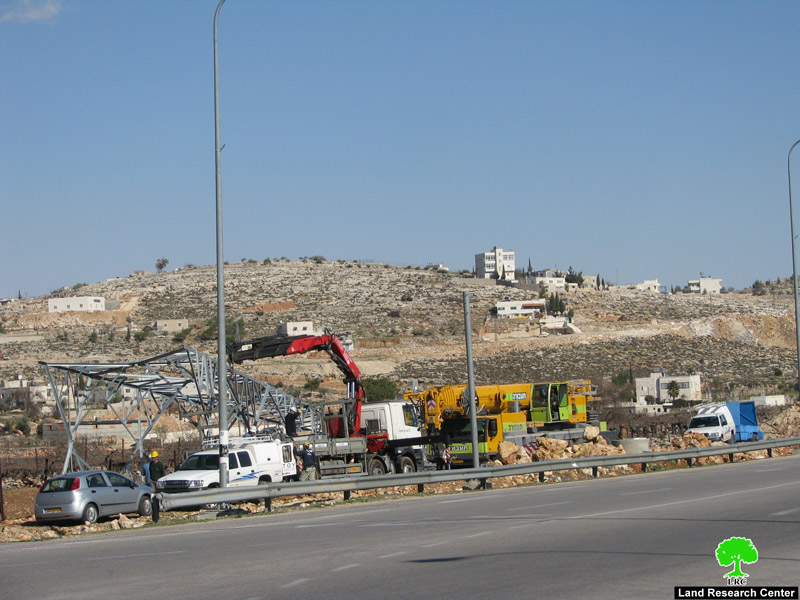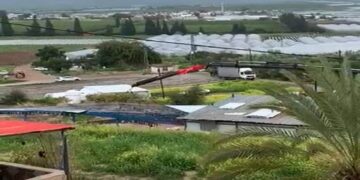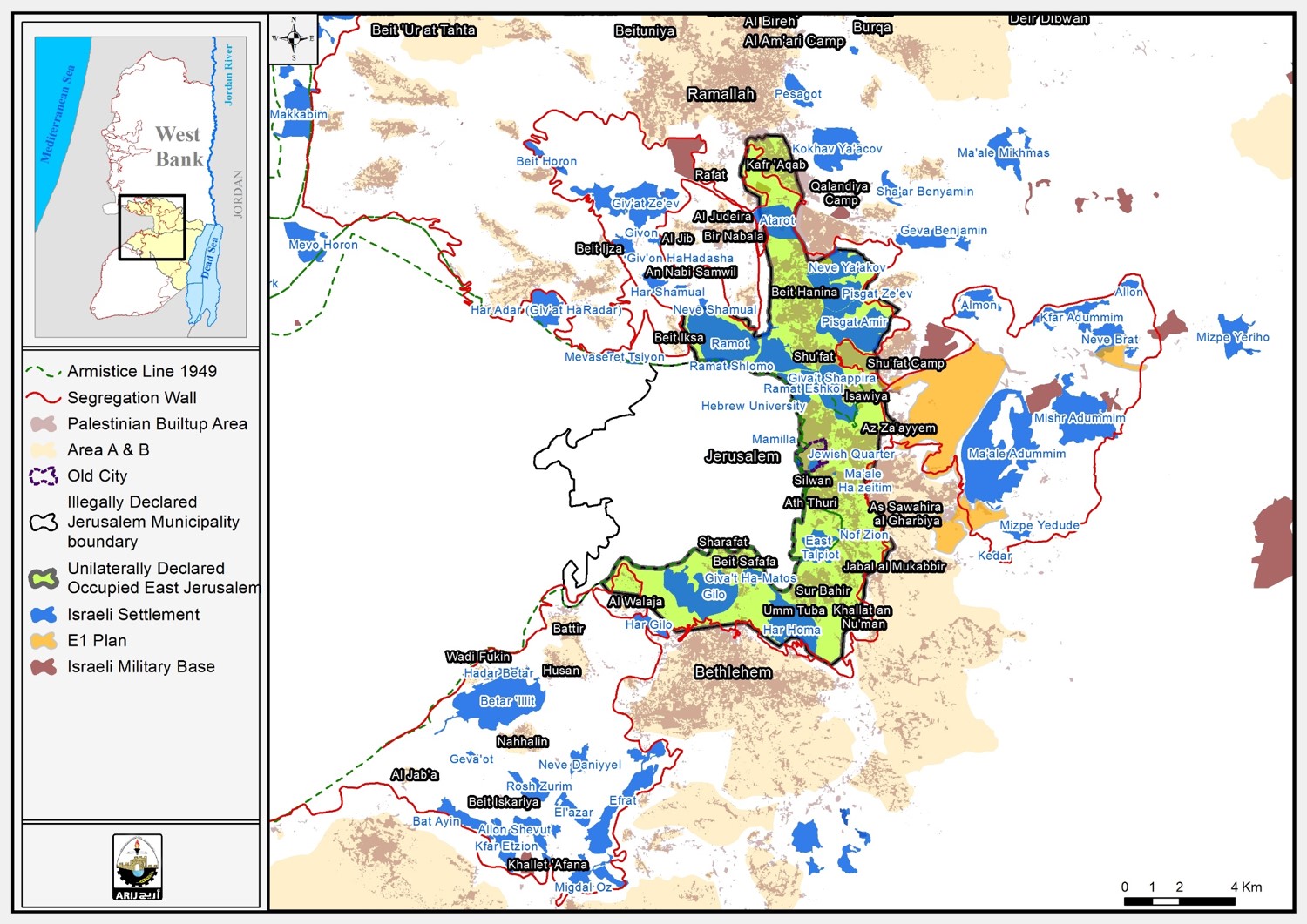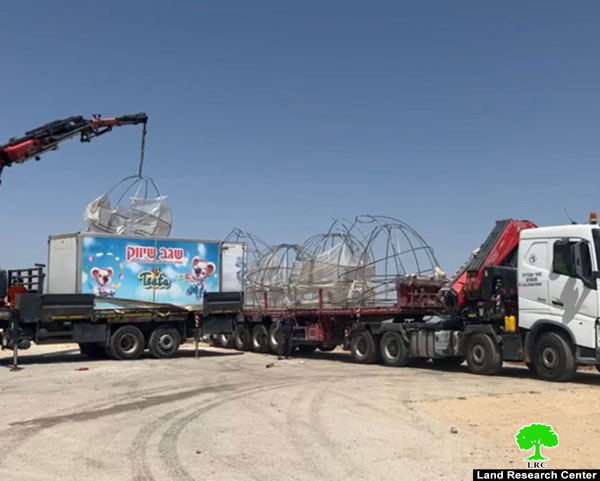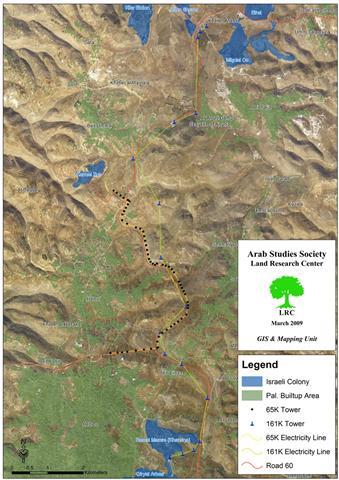Israeli occupation forces have plowed large areas of Palestinian agricultural lands to establish a network of high voltage electricity lines to serve Israeli colonies built atop Palestinian lands.
The electrical lines are planned to be established using hundreds of Palestinian dunums in the governorates of Hebron and Bethlehem. Affected villages include Nahallin and Al Khader in Bethlehem Governorates as well as Beit Ummar, Halhul, Sa�ir, Beit Einoon, Hebron city as well as Taqumiya in Hebron Governorate.


Photo 1 & Photo 2: High voltage towers built on Palestinian lands.
Israeli occupation forces began the first phase of the project in July 2007 which ended in the first few months of 2008. The phase consisted of installing a 65 kilovolt power lines that would function to provide the colony of Karmi Tzur with electricity. Electrical poles were installed on both sides of By-Pass Road 60 for this purpose.
The second phase of the project has already started and is considered to be more dangerous than the first stage. That is due to the fact that it calls for the installation of high voltage towers starting from the electrical station in the colony of Kiryat Arba until it reaches the colony of Bitar Illit west of Bethlehem. The colony of Telem (built atop Tarqumia lands in Hebron) will also be served by the towers as well as all military towers and observation points located on both sides of By-Pass Road 60 in both governorates.
The number of the planned high voltage towers that are designed to handle 161,000 kilo Watts of electricity is 17. As for the towers designed to handle 65 kilo Watts, there will be 56 of them installed. According to field observations, the town of Halhul has so far 3 high voltage towers (the 161,000 kilo Watt type) and around 32 towers of the 65 kilo Watts type tower constructed upon its lands. The numbers are expected to rise as occupation forces are continuing to implement the project.

 Photo 3 & Photo 4: Israeli machinery during the installation of high voltage towers.
Photo 3 & Photo 4: Israeli machinery during the installation of high voltage towers.
Large tracks of Palestinian lands are due to be lost because of the installation of the towers; in total, lands lost due to the installation of the 161,000 kilo Watt towers are around 1207 dunums while lands lost due to the installation of the 65 kilo Watt towers approach 85.2 dunums. The town of Halhul stands to lose 240 dunums due to the installation of the first type of tower in addition to 10 dunums due to the installation of the second type.
The Effects of the Installation of the Towers:
The existence of the towers atop Palestinian lands affects all aspects of Palestinian lives especially those located in the vicinity of Palestinian homes and farm lands. The negative affects are listed below:
A) Agricultural lands:
-
The network of towers has destroyed additional parts of Palestinian farming lands. Hundreds of dunums were plowed to make the bases for the towers while additional dunums were leveled to make way for the construction materials and cranes to reach the location of the towers.
-
The high voltage towers will, in effect, prevent Palestinians owning lands near the towers from reaching in fear of electrical shocks especially during the winter season.
Photo 5: The plowing of large tracks of lands for the installation of the
electrical towers in the area of Dhaher Al Baw� in the city of Halhul.
B) Palestinian building:
-
The installed towers will prevent Palestinians from building or adding new floors to their existing homes as multiple-stories are prohibited in the vicinity of the towers. As such, in the city of Halhul around 80 houses are affected by this restriction.
-
Palestinian building will be prohibited 40 meters away from the base of the tower in all four directions.

Photo 6: The high voltage towers close to Palestinian houses in Beit Einoon.
C) Health:
The electrical waves being emitted by the towers has a negative effect on the health of the population living in its vicinity. These waves are known to be causing cancer which will negatively impact the lives of hundreds of Palestinians. For example, in the city of Halhul there are 1,000 Palestinians living in the vicinity of these towers.
Dr. Ziad Abu Yousef, the Mayor of Halhul, expressed the following: ‘ The owners of damaged lands due to the towers came to my office. The Municipality carried out a visit to the affected locations. While we were at one of the locations Israeli soldiers approached us and told us to immediately vacate the location and to let the contractor continue his work. They have also mentioned that there is a military order authorizing the project. When, however, we requested a copy of the order, the soldiers refused to provide us with a copy. Some of the land owners tried to reach their lands, yet they were prevented by the occupation forces. The Municipality has appealed to a number of rights and land defense organizations and filed complaints with them in an effort to stop the land grab, yet to no avail.’
In turn, Mr. Abu Yousef demanded an immediate end to the violations and belligerent acts of the Israeli forces against Palestinians and their property. As a result of such acts, Palestinian farmers have access to small portions of their lands due to these acts and policies.
What’s Next?
At the time that Israeli occupation forces prevent Palestinian farmers from accessing and using their lands, it grabs these lands in order to create large scale projects and networks for the benefit of its colonist population in the West Bank
The Land Research Center (LRC) condemns the Israeli occupation policies that aim at providing all services for the colonist population at the expense of the lands and property of the Palestinians as well as their future expansion. The LRC also calls upon the international community, specifically the European Union, to exert pressure on the Israeli occupation government to stop its destructive policies towards Palestinian farmers and their lands.








